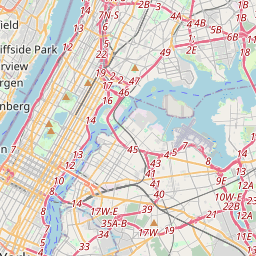Naters Memorial Park
Historical marker location:
Secaucus, New Jersey
( Memorial is at the intersection of Koelle Blvd. and Blondel Drive, on the left when traveling north on Koelle Blvd..)







© OpenStreetMap contributors
Loading...
Searching for other points of interest within 3 miles of this location.The first organized drive-in movie theater in the world opened in Camden, New Jersey in 1933. The concept quickly caught on and drive-in theaters became a popular form of entertainment across the United States.
About Hudson County
Hudson County Timeline
Hudson County, located in the northeastern part of New Jersey, has a rich and diverse history that dates back centuries. The area was initially inhabited by the Lenape Native Americans before the arrival of European settlers. In the early 17th century, Dutch traders established the settlement of Bergen, making it one of the earliest permanent European settlements in the region.
During the American Revolutionary War, Hudson County played a strategic role due to its location near New York City. It was the site of several skirmishes and was occupied by both American and British forces at various times. After the war, the county experienced rapid industrialization and urban development, fueled by the growth of the shipping, manufacturing, and trade industries.
In the mid-19th century, waves of immigrants, including Irish, German, and Italian, came to Hudson County, seeking employment in the burgeoning industries. This immigration wave, coupled with the industrial boom, led to the establishment of vibrant ethnic neighborhoods and a diverse cultural landscape that continues to this day.
In the 20th century, Hudson County faced numerous challenges but also experienced periods of growth and transformation. The area saw waves of immigration from Eastern Europe and Latin America, contributing to its cultural diversity. Over the years, the county underwent revitalization efforts to attract investments, improve infrastructure, and enhance the quality of life for its residents.
Today, Hudson County is a vibrant and dynamic community, known for its bustling cities, diverse population, and proximity to New York City. It continues to evolve and thrive, blending its rich history with modern urban life.
During the American Revolutionary War, Hudson County played a strategic role due to its location near New York City. It was the site of several skirmishes and was occupied by both American and British forces at various times. After the war, the county experienced rapid industrialization and urban development, fueled by the growth of the shipping, manufacturing, and trade industries.
In the mid-19th century, waves of immigrants, including Irish, German, and Italian, came to Hudson County, seeking employment in the burgeoning industries. This immigration wave, coupled with the industrial boom, led to the establishment of vibrant ethnic neighborhoods and a diverse cultural landscape that continues to this day.
In the 20th century, Hudson County faced numerous challenges but also experienced periods of growth and transformation. The area saw waves of immigration from Eastern Europe and Latin America, contributing to its cultural diversity. Over the years, the county underwent revitalization efforts to attract investments, improve infrastructure, and enhance the quality of life for its residents.
Today, Hudson County is a vibrant and dynamic community, known for its bustling cities, diverse population, and proximity to New York City. It continues to evolve and thrive, blending its rich history with modern urban life.
Hudson County Timeline
This timeline provides a condensed summary of the historical journey of Hudson County, New Jersey.
- 1600s - Hudson County was originally inhabited by the Lenape Native American tribe
- 1609 - Henry Hudson sails past the area while exploring the Hudson River
- 1660 - Dutch settlers establish the village of Bergen, the first permanent European settlement in the area
- 1664 - The British take control of the area from the Dutch and rename Bergen to Bergen Township
- 1776 - During the American Revolution, British forces occupy Hudson County
- 1804 - Jersey City is established as a town, named after the nearby state of New Jersey
- 1840s - Industrialization begins in Hudson County, with the opening of factories and shipyards
- 1861-1865 - Many residents of Hudson County fight in the American Civil War
- 1870 - Hudson County becomes an important transportation hub with the completion of the Hudson and Manhattan Railroad
- 1908 - Construction of the Holland Tunnel begins, connecting Hudson County to New York City
- 1916 - The Black Tom explosion occurs in Jersey City, an act of sabotage during World War I
- 1960s - Urban renewal projects lead to the construction of new residential and commercial buildings
- 1982 - The County of Hudson is officially established